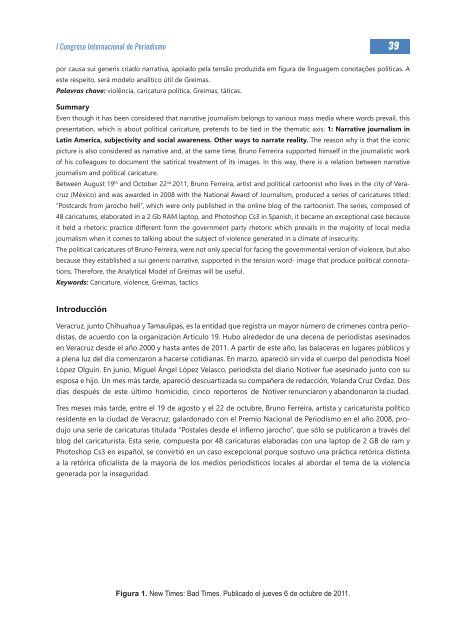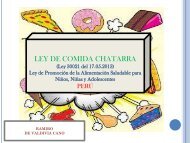ACTAS
2oUssoJ
2oUssoJ
Create successful ePaper yourself
Turn your PDF publications into a flip-book with our unique Google optimized e-Paper software.
I Congreso Internacional de Periodismo 39<br />
por causa sui generis criado narrativa, apoiado pela tensão produzida em figura de linguagem conotações políticas. A<br />
este respeito, será modelo analítico útil de Greimas.<br />
Palavras chave: violência, caricatura política, Greimas, táticas.<br />
Summary<br />
Even though it has been considered that narrative journalism belongs to various mass media where words prevail, this<br />
presentation, which is about political caricature, pretends to be tied in the thematic axis: 1: Narrative journalism in<br />
Latin America, subjectivity and social awareness. Other ways to narrate reality. The reason why is that the iconic<br />
picture is also considered as narrative and, at the same time, Bruno Ferrerira supported himself in the journalistic work<br />
of his colleagues to document the satirical treatment of its images. In this way, there is a relation between narrative<br />
journalism and political caricature.<br />
Between August 19 th and October 22 nd 2011, Bruno Ferreira, artist and political cartoonist who lives in the city of Veracruz<br />
(México) and was awarded in 2008 with the National Award of Journalism, produced a series of caricatures titled:<br />
“Postcards from jarocho hell”, which were only published in the online blog of the cartoonist. The series, composed of<br />
48 caricatures, elaborated in a 2 Gb RAM laptop, and Photoshop Cs3 in Spanish, it became an exceptional case because<br />
it held a rhetoric practice different form the government party rhetoric which prevails in the majority of local media<br />
journalism when it comes to talking about the subject of violence generated in a climate of insecurity.<br />
The political caricatures of Bruno Ferreira, were not only special for facing the governmental version of violence, but also<br />
because they established a sui generis narrative, supported in the tension word- image that produce political connotations.<br />
Therefore, the Analytical Model of Greimas will be useful.<br />
Keywords: Caricature, violence, Greimas, tactics<br />
Introducción<br />
Veracruz, junto Chihuahua y Tamaulipas, es la entidad que registra un mayor número de crímenes contra periodistas,<br />
de acuerdo con la organización Artículo 19. Hubo alrededor de una decena de periodistas asesinados<br />
en Veracruz desde el año 2000 y hasta antes de 2011. A partir de este año, las balaceras en lugares públicos y<br />
a plena luz del día comenzaron a hacerse cotidianas. En marzo, apareció sin vida el cuerpo del periodista Noel<br />
López Olguín. En junio, Miguel Ángel López Velasco, periodista del diario Notiver fue asesinado junto con su<br />
esposa e hijo. Un mes más tarde, apareció descuartizada su compañera de redacción, Yolanda Cruz Ordaz. Dos<br />
días después de este último homicidio, cinco reporteros de Notiver renunciaron y abandonaron la ciudad.<br />
Tres meses más tarde, entre el 19 de agosto y el 22 de octubre, Bruno Ferreira, artista y caricaturista político<br />
residente en la ciudad de Veracruz, galardonado con el Premio Nacional de Periodismo en el año 2008, produjo<br />
una serie de caricaturas titulada “Postales desde el infierno jarocho”, que sólo se publicaron a través del<br />
blog del caricaturista. Esta serie, compuesta por 48 caricaturas elaboradas con una laptop de 2 GB de ram y<br />
Photoshop Cs3 en español, se convirtió en un caso excepcional porque sostuvo una práctica retórica distinta<br />
a la retórica oficialista de la mayoría de los medios periodísticos locales al abordar el tema de la violencia<br />
generada por la inseguridad.<br />
Figura 1. New Times: Bad Times. Publicado el jueves 6 de octubre de 2011.



